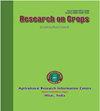Evaluating the efficiency of Chelex 100 for DNA extraction in orange (Citrus sinensis)
Q3 Agricultural and Biological Sciences
引用次数: 0
Abstract
Plant research has recently concentrated on the molecular level, which requires reliable, inexpensive, and fast protocols for extracting DNA. Many researchers have identified Chelex-based DNA extraction methods as having the potential to reduce costs. However, Chelex can also prevent DNA degradation by chelating metal ions. Citrus is one of the top three crops grown globally, with oranges being a well-known species. Therefore, study on the molecular of C. sinensis is essential. This study was conducted in 2022 at the genetic lab of the University of Limpopo- to compare two different extraction methods for DNA from C. sinensis. The DNA from the C. sinensis leaves was extracted using Chelex "method 1" (overnight incubation at 56°C) and "method 2" (Ten-minute incubation at 95°C). A spectrophotometer was employed to measure the extracted DNA's qualitative and quantitative parameters accurately. Furthermore, all samples were subjected to PCR reactions with primers for 28S. The results indicated that "method 2" (1.59-1.84) proved to be the most effective method to obtain high-quality extracted DNA. Additionally, the quantitative and qualitative tests for PCR reaction demonstrated that "method 2" produced better results. In conclusion, although both methods yielded favourable outcomes, "method 2" was ultimately the more successful approach.评估 Chelex 100 在柑橘中提取 DNA 的效率
植物研究最近集中在分子水平,这就需要可靠、廉价和快速的 DNA 提取方案。许多研究人员发现,基于 Chelex 的 DNA 提取方法具有降低成本的潜力。不过,Chelex 还能通过螯合金属离子防止 DNA 降解。柑橘是全球三大作物之一,其中橙子是著名的品种。因此,对柑橘分子的研究至关重要。这项研究于 2022 年在林波波大学的基因实验室进行,目的是比较从中华橘中提取 DNA 的两种不同方法。采用Chelex "方法1"(56°C过夜孵育)和 "方法2"(95°C十分钟孵育)从中华皂苷叶片中提取DNA。使用分光光度计精确测量提取 DNA 的定性和定量参数。此外,所有样品都用 28S 引物进行了 PCR 反应。结果表明,"方法 2"(1.59-1.84)是获得高质量提取 DNA 的最有效方法。此外,PCR 反应的定量和定性测试表明,"方法 2 "的结果更好。总之,虽然两种方法都取得了良好的结果,但 "方法 2 "最终是更成功的方法。
本文章由计算机程序翻译,如有差异,请以英文原文为准。
求助全文
约1分钟内获得全文
求助全文
来源期刊

Research on Crops
Agricultural and Biological Sciences-Soil Science
CiteScore
1.50
自引率
0.00%
发文量
93
审稿时长
1 months
期刊介绍:
The Research on Crops is a peer-reviewed journal publishing original research papers, review articles and short communications in English on all basic and applied aspects of crop sciences, agricultural water management, agro-climatology, agroforestry, agronomy, crop production, crop protection, cropping systems, food science & technology, genetics & plant breeding, horticulture, plant & soil science, plant biotechnology, plant nutrition, post-harvest management of crops, seed science, soil management & tillage, vegetables, weed science, agricultural engineering, agri-business, agricultural economics and extension, etc. The aim of the journal is to provide a forum for the scientific community to publish their latest research findings.
The manuscripts submitted for publication should not contain data older than 4 years on the date of submission.
The articles submitted for publication in this journal should not be submitted elsewhere simultaneously for publication in another journal. These should not carry any copyright material without prior permission of copyright holder.
The articles should present a complete picture of the investigation made and should not be split into parts.
There is no prescribed limit regarding the number of pages in case of full-length articles. However, the authors are advised to keep the length of their articles from 4 to 10 full printed pages of the journal.
The articles should be divided into the sub-sections: ABSTRACT, INTRODUCTION, MATERIALS AND METHODS, RESULTS AND DISCUSSION, CONCLUSIONS, and REFERENCES. Tables and figures should be appended separately at the end.
 求助内容:
求助内容: 应助结果提醒方式:
应助结果提醒方式:


